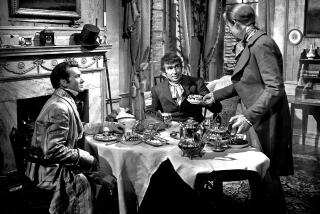The Phenomenal Persistence of David Lean : At 81, the director fields several honors and awaits the start of his next project--Conradâs âNostromoâ
LONDON â After years of living in Rome, Sir David Lean a few years ago bought three wharves alongside the Thames in the docklands area of East London, in the section immortalized by âLimehouse Blues.â
He razed two of the wharves, retaining only the high brick wall on the street side and creating a lovely tree-shaded grassy terrace between the wall and the river. The third, Sun Wharf, he has converted (rebuilt actually) into his home. It is all brick and beams, solidly masculine, with massive windows on the second level from which Lean can watch the ceaseless river traffic, including the tour boats chugging down to Greenwich and back.
It is a gloriously comfortable home, filled with plants, and with mementos of a six-decade career. It gives the impression of having been lived in for many years rather than just the three since the redesign was finished. But, by his present plan, Lean will be leaving it temporarily to go to work abroad again.
In the new year, almost as he turns 82 (on March 25), Lean expects to begin work on a new epic film of Joseph Conradâs 1904 novel âNostromo,â a complex and timely story about exploitation, greed and revolution in a mythical South American country called Costaguana. The silver from its mines changes and generally corrupts almost all who touch it.
âI started (reading) it five times and couldnât get beyond page 180,â Lean told a visitor during a brilliantly sunlit afternoon a few weeks ago. âThen I did and it really takes off.â
The French producer Serge Silberman, who produced all of Luis Bunuelâs last films, has now raised the $30 million the production will cost, Lean says.
Leanâs frequent collaborator, Robert Bolt (âLawrence of Arabia,â âDoctor Zhivago,â âRyanâs Daughterâ) has written the shooting script, after a first go by Christopher Hampton. âChristopher writes in pastels,â Lean explains, leaving it unsaid that Lean prefers primary colors.
Casting is not complete, but Bolt says he has a commitment from Marlon Brando to play a general in the film. âWeâve known each other a long time. I sent him the script and said, âI think youâll enjoy doing it.â He jumped at it and said heâd love to do it. When you see Brando now against the modern stars, he jumps off the screen and they become part of the wallpaper. You donât see them.â
His âNostromoâ will be the French-raised Greek actor George Corafas, who was in Peter Brooksâ monumental Indian stage drama, âThe Mahabharata.â Eric Porter, the Soames Forsyte of televisionâs âThe Forsyte Saga,â will play Dr. Monygham. The central figures, the mine owner Charles Gould and his sensitive young wife, are challenging to cast and Lean is still looking.
Mojacar, on the Spanish coast not far east of Almeria, a favorite site for location shooting during Hollywoodâs runaway â60s, will double for Costaguana. A tourist brochure makes it look very much like the offshore view of Costaguana as Conrad describes it. Lean knows it well; it was at Mojacar that he filmed the great desert charge in âLawrence of Arabia.â
âAt the end of his life,â Lean says, âConrad toyed with the idea of making âNostromoâ into an opera, and it has a kind of sense. Itâs way over the top. I confess I love things that are not quite real.â
These have been several notable months for Lean, commencing with the great commercial and critical success of the restored âLawrence of Arabia,â which after two yearsâ work under Leanâs guidance had all the parts put back in that had been eviscerated to create a shorter running time for cinemas and then television.
âEveryone worried about re-releasing âLawrence.â They said the audiences have changed. They talk and shout at the screen; theyâre impatient; they wouldnât sit still for it. Not at all. You could hear a pin drop. London, New York, Washington, Los Angeles. Everywhere.â
What critics who had seen the truncated versions noticed was how much subtler the study of Lawrenceâs character was when the dozens of bits and pieces (few of them really major scenes) were edited back in. âIt was a subtle piece of work,â Lean says, âdepicting Lawrence and his character. Itâs less than 1% of the film in terms of footage, but itâs the cumulative effect of nuances, and if you dig out too many youâve lost a whole hunk of his character.â
The Lean trademark is of impeccable, perfectionist workmanship, most often in later years put to the service of epic events or environments played against intimate private dramas. At the center of the sweeping desert battles in âLawrenceâ was a curiously fragile man concerned about his manhood--a subtext in the film that had been shot, was lost and then found again. âI think audiences had almost forgotten the power of pictures. Theyâve gotten smaller and smaller. And suddenly you see this old film, wonderfully photographed; tremendous detail; you almost feel you could take a hair off the actorâs collar. Thereâs a mesmeric effect from the picture on the screen.â
Like David Puttnam, Lean thinks âThe Godfatherâ was the last great picture. He is cheered to hear that Bernardo Bertolucci has been shooting a film in 70mm in Morocco. âHats off to that,â Lean says. He would love to do âNostromoâ in 70mm, but the cost is high for an already expensive picture.
Lean is being draped with honors these days. He has been named as the American Film Instituteâs Life Achievement Award, joining a succession that began with John Ford and has included Orson Welles, Alfred Hitchcock and William Wyler among other distinguished creators. Lean is the first honoree who has not worked principally in Hollywood. The award will be given in an elaborate presentation in March.
There has been a major retrospective of his work at the Los Angeles County Museum of Art. He was honored at a star- and royalty-studded dinner during the Cannes Film Festival last May. And, perhaps most surprising to his friends, he allowed himself to be interviewed at length for a handsome pictorial biography of the man and his work by critic Stephen Silverman.
âDavid Leanâ (Abrams: $35.50, 208 pp.) is interesting not least for the candor with which Lean admitted that the reviews of âRyanâs Daughterâ devastated him and almost paralyzed him creatively. It was 14 years before he made âA Passage to Indiaâ (though he worked for several years on a remake of âMutiny on the Bountyâ that in the end he did not do).
âThe notices,â he told a recent visitor, âwere vitriolic, as theyâd been on âZhivagoâ as well. The Germans were the worst of the lot. It becomes like a kind of brush fire. I told myself then, and tell myself now, the film wasnât really as bad as that. But the critics turn like a pack of wolves. Now--touch wood--theyâre really nice to me again.
âI remember my brother (Edward Tangye Lean, who ran the Overseas Service of BBC Radio) once saying, after Olivier had had his troubles with the critics and been forgiven, as it were, âWell, now Larry Olivier has passed through the Envy Belt.â â
There are revelations in the book, notably about Leanâs often difficult relations with his actors. One joke was that in the end Katharine Hepburn would have to play all the parts because only she got along with him. (They did just one film together, âSummertimeâ in 1955. Hepburn contributes an introduction to the Silverman book.)
Clarifying one story, Lean says that Albert Finney did four days of tests for âLawrenceâ and Lean very much wanted him for the part. But producer Sam Spiegel, with whom Lean fought hard and often but grudgingly admires in retrospect for his sheer daring, demanded Finney sign a multipicture contract. Finney, who has always prefered creative freedom above stardom, would have no part of it.
âFinney turned it down, rightly. Sam got contracts like that with Peter OâToole and Omar Sharif and he used them mercilessly in bad parts, Omar especially.â
Lean, desperate after Finneyâs refusal, says he looked at every film in view and spotted OâToole in a small part in âThe Day They Robbed the Bank of England.â
âHe was fishing for trout, playing a silly ass. But he was damned good looking. I said, âSam, Iâve found Lawrence.â Sam said, âWhatâs his name?â I told him and his face went blank. He said, âHeâs no good.â â
There was, Lean learned a few years later, a back story. OâToole had been standing in for Montgomery Clift on Spiegelâs âSuddenly Last Summerâ and Spiegel had agreed to screen test him. He assigned it to an assistant who did it with no more flair than a police line-up photo (âLeft, right, full face,â Lean says). Someone saw it and cracked, âMr. Spiegel, your son will never learn to play the violin.â Sam hadnât forgotten the crack.
â âBut weâve got the set, and all that sand, lots of sand, letâs test him,â I told Sam.â And they did, changing OâTooleâs life.
Lean, surprisingly, has had an in and out relationship with Sir Alec Guinness, whom he first cast, unforgettably, as Herbert Pocket in âGreat Expectationsâ when Guinness was 26 and just out of the Navy. As Lean told Silverman, Guinness hated the theme of âBridge on the River Kwai,â had to be virtually dragooned into doing it. He argued with Lean about the script throughout.
He and Lean also fought over the characterization of Professor Godbole in âA Passage to India.â âIt was a simple thing,â Lean said not long ago. âHe was deathly afraid of doing a parody of a Peter Sellers Indian. I told him to play it straight and heâd be fine. But he kept doing these tricky things and in the end Iâm afraid he did exactly what he was afraid of doing. We had to cut chunks of it out. And then Alec went public with it, went to the Sunday Times (of London). Too bad.â The breech is not irreparable, Lean thinks; his admiration for Guinness is enormous.
Lean, after years of avoiding publicity, agreed in mid-1987 to talk with Silverman and is very pleased with the finished book, although he told Silverman there is too much in it about his Quaker childhood in suburban Croydon. Still, the experience as a whole delighted him and he is now in the talking stages of yet another book, with film historian Kevin Brownlow. That one, Lean says, will be less biographical and anecdotal and more about the doing of the work.
He has been doing the work for more than 60 years, having begun as a tea-boy when he was 19 and worked his way up through the editing room to his big break, co-directing âIn Which We Serveâ with Noel Coward. (When Coward read him the first draft of the script, Lean estimated it would run five hours and he urged Coward to go see âCitizen Kane.â Coward did and rewrote the script in two weeks.)
âDavid is sweet--simple and straight--and strong and savage; and he is the best movie director in the world,â Hepburn says in her introduction. âAnd nothing--did you hear me?--I said nothing gets in his way. Heâll stand and look and stare. He wonât be hurried. He wonât budge until he can smell perfection.â
Lean is also leonine and imperious, and his dedication to his work has had obvious costs. He has been married five times and has a new companion at the moment. He is a lively conversationalist but, like Hitchcock, conducts it without revealing a great deal about the private man.
âYou wonât get much out of me, Iâm afraid,â he told Silverman when he agreed to do the book. In fact, Silverman did, including the revelations about Leanâs dark despairs when the critics made him doubt his own gifts. But the revelations also suggested, like partial reflections on a pool, what other hidden depths are likely there.
Not least there is something to be found, perhaps a secret, perhaps only a trait of character, about Leanâs phenomenal persistence of vision in the pursuit of perfection. In the case of âLawrence of Arabia,â his vision of what he wanted lasted intact for more than five years, from first conceptions of the film to the final edit. Fatigue, boredom, indecision or sharply altered perceptions might well send other men off on tangents. Lean waits, unbudged, for what Hepburn calls the smell of perfection. He may be no better at explaining how he does it than his admirers are.
Preparing to tackle another very large film, with apparently undiminished vigor and drive at nearly 82, Lean is cheered by the thought that audiences are rediscovering the full power of film at its most majestic.
âThe old boys knew it. They loved the movies, Cohn, Mayer, Goldwyn, and they took big chances. Goldwyn got hold of the idea that the important thing in making movies is quality, and he never let go. I think it can come back. The audiences are beginning to appreciate quality. They say, âIs it a good print?â They know.â
Lean has made clear that âNostromoâ is not to be his last film. He told Silverman heâd like to do a film about early Hollywood, and heâd like to do an original musical.
Why not?
LEANâS FILMS
âIn Which We Serve,â (co-director with Noel Coward) 1942
âThis Happy Breedâ 1944
âBlithe Spiritâ 1945
âBrief Encounterâ (and screenplay with Ronald Neame and Anthony Havelock-Allan) 1945
âGreat Expectationsâ (and screenplay with Neame and Havelock-Allan, with Kay Walsh and Cecil McGivern) 1946
âOliver Twistâ (and screenplay with Stanley Haynes) 1948
âThe Passionate Friendsâ 1949
âMadeleineâ 1950
âThe Sound Barrierâ (and producer) 1952
âHobsonâs Choiceâ (and producer and co-screenplay with Norman Spencer and Wynard Browne) 1954
âSummer Madnessâ (and screenplay with H. E. Bates) 1955
âThe Bridge on the River Kwaiâ 1957
âLawrence of Arabiaâ 1962
âDoctor Zhivagoâ 1965
âRyanâs Daughterâ 1970
âA Passage to Indiaâ (and screenplay) 1984
More to Read
Only good movies
Get the Indie Focus newsletter, Mark Olsen's weekly guide to the world of cinema.
You may occasionally receive promotional content from the Los Angeles Times.










